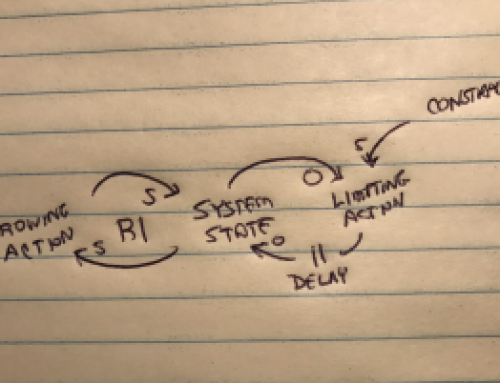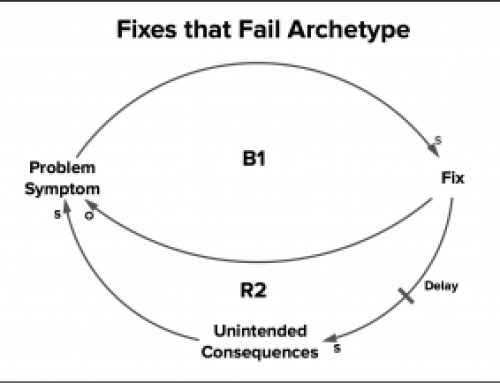In my last post, I presented a quadrant analysis of Leadership. In today’s post, I want to take a look along similar axis (vision and effectiveness) but in terms of overall organization effectiveness. Before jumping into the discussion of each quadrant, I want to introduce the “PAEI” letters you see above in case you are not familiar with Ichak Adizes work and writings in the area of corporate lifecycles and regarding the four prototypical leadership styles that he presents.
Background on “PAEI”
Adizes is widely recognized by scholars and many practitioners for his view of organizations from a lifecycle perspective. Basically, he puts forward, that like living things, all organizations are born, live, go through predictable cycles of life, and then die. The overarching leadership forces at work that can intervene in this consistent process to reinvigorate the organization and return to an earlier stage are generally “effectiveness” and “efficiency” in terms of leadership and are represented in four prominent leadership styles (P, A, E, and I) that are found in different quantities in various stages of the organizational lifecycle. If you desire a much deeper understanding of Adizes’ work, you can refer to various articles and books bearing his name and easily found, including Management/Mismanagement Styles and Managing Corporate Lifecycles.
The following is an explanation of “PAEI”:
- (P)roducing is the activity of attaining short term or immediate results.
- (A)dministrating is the activity of minimizing waste in ongoing activities
- (E)ntrepreneuring is the activity of seeking out and recognizing new opportunities or new orientations to the environment
- (I)ntegrating is the activity of coordinating shared attention and identification
Organizational Effectiveness and Leadership Style Combinations
Like the Leadership Effectiveness chart, we again have four quadrants, but this time the quadrants represent four types of organizational effectiveness along the axis of vision and effectiveness.
The first quadrant I call Slowly Dying. The leadership style combination during this phase of an organization is generally “pAei”, where Administrating is more dominant. Everything works well and things feel generally comfortable. Longs standing pay and bonus structures are served well, things run as they always have even if revenues are slipping, and without intervention things will just slowly spiral down. Sometimes there is even an acquisition or two, but generally unless the overall management style is infused with new dominant influences from Entrepreneurs or Producers & Entrepreneurs, the slow death will continue.
The second quadrant is the Wild West. Who doesn’t like the wild west where rules seem to be suspended as the Entrepreneurs and Producers can dominate (“PaEi”) and pursue any and all ideas. This is a very necessary phase of any organization as it grows but is completely unsustainable as a company grows and must become more accountable for its own growth and survival. Recruiting sales personnel into this organization is not hard, but keeping them can be hard without structure to support sales or keep up with sales (frequently promising something we can’t deliver … yet).
If progressing as it should, an organization should move from the Wild West to the Growth/Synergy phase by having the full presence and influence of all four leadership types “PAEI” in balanced proportion over time. Everything is working together for optimal growth in a receptive external environment. As in the Leadership Effectiveness Quadrant I discussed in my prior post, I don’t believe that one leader is going to bring a balanced “PAEI” style to the party. This phase occurs when as a whole, the key leadership of the company is diversified in terms of their “PAEI”, the right leadership skills are deployed to the right tasks, and when the dominance of attention to each rises and falls as necessary in handling specific situations/conditions. The danger then becomes complacency and of course, allowing the “A”‘s to rise up and take control!
The last quadrant to discuss is the Stable-Aging quadrant. This quadrant is where organizations can end up just after Growth/Synergy and just before Slowly Dying. In fact, it is likely that every organization will naturally slide into this spot where the company is running like a machine before anyone notices. In this stage, Integrators dominate and ensure that the machine is integrated and things keep relating to each other properly (“paeI”). E and P are just starting to fade a bit. That’s okay. It’s kind of inevitable. In fact, the key is to recognize this and then examine ways to interject some of the missing drivers (more “E” .. more “P” particularly) to slide back into the previous stage or maybe even go back to the Wild West with some new initiatives.
After considering this for a while along with my experiences and observations of various companies and industries, I would have to say that once you grow a company or part of a company through the Wild West to the Growth Synergy and then the Stable-Aging phases, what happens next will depend on a few key factors:
- Are you in this stable-aging phase more because of market conditions or more from drift from purpose and leadership?
- Can you return and repeat the wild-west through growth and then stable phases in that same market through new products or services?
- Should you take the good money coming in from the stable-aging and launch more new endeavors and grow through the wild-west and so on to “conceive” new life so to speak?
These are just a few questions and this is not the forum for the deep dive into examining corporate life cycles. However, doing nothing at this phase will certainly start to mobilize the “A” style even more to “create an orderly process to exist and survive” until there is death in the organization.
It’s always interesting to apply a model where there are styles, or letters, or titles for phases; however, what is important to remember is that any organization will be most effective when there is clear vision that responds accurate to the external environment and when the organization is effective and efficient in executing/implementing the strategy that moves towards that vision together.


